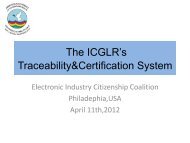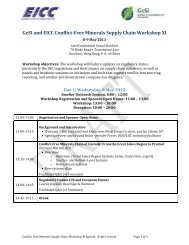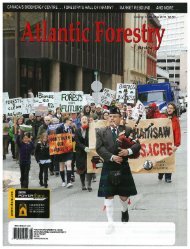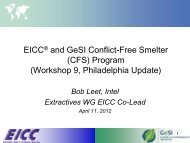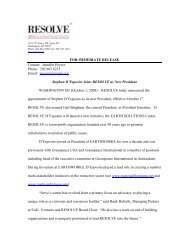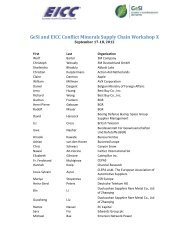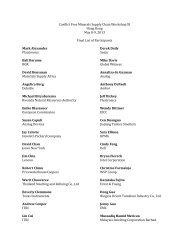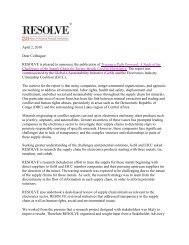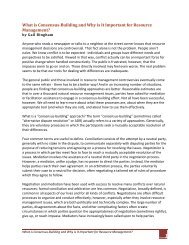Toward SuSTainabiliTy: The roleS and limiTaTionS of ... - Resolve
Toward SuSTainabiliTy: The roleS and limiTaTionS of ... - Resolve
Toward SuSTainabiliTy: The roleS and limiTaTionS of ... - Resolve
You also want an ePaper? Increase the reach of your titles
YUMPU automatically turns print PDFs into web optimized ePapers that Google loves.
Introduction 3work at the scale required.) As a follow-up, Mars<strong>and</strong> the Packard Foundation—together with theWalton Family Foundation—joined forces tosupport the organization <strong>of</strong> a multi-stakeholdercollaborative analysis <strong>of</strong> the state <strong>of</strong> knowledgeregarding st<strong>and</strong>ards <strong>and</strong> certifications systems.This analysis eventually came to be known asthe State-<strong>of</strong>-Knowledge Assessment <strong>of</strong> St<strong>and</strong>ards<strong>and</strong> Certification. <strong>The</strong> three organizations providedgrant support for RESOLVE, a nonpr<strong>of</strong>itmediation <strong>and</strong> facilitation organization, to serveas Secretariat for the Assessment.In September 2009, RESOLVE <strong>and</strong> the Assessmentorganizers convened 34 experts, representing abroad array <strong>of</strong> interests <strong>and</strong> sectors, to providefeedback <strong>and</strong> ideas on the Assessment process<strong>and</strong> approach. Subsequently, the organizersinvited a small but diverse group <strong>of</strong> individualsto form the Assessment’s Steering Committee.<strong>The</strong> first Steering Committee call took place inDecember 2009, at which time the Committeeitself took responsibility for the process <strong>and</strong> workplan<strong>and</strong> proceeded to invite several additionalparties to join.Participation<strong>The</strong> composition <strong>of</strong> the Steering Committeeis diverse, with representatives from corporations,environmental organizations, certifyingorganizations, <strong>and</strong> academia. (See Appendix N.)<strong>The</strong> Committee sought to include governmentrepresentation as well, but the agency <strong>of</strong>ficialsapproached said they preferred to stay informed<strong>of</strong> the proceedings but not involved.Process<strong>The</strong> Steering Committee met in full plenary sessionfive times: in March <strong>and</strong> October 2010, <strong>and</strong>in March, July, <strong>and</strong> November 2011. <strong>The</strong>y alsomet numerous times in conference calls <strong>and</strong>working groups. (See Appendix M for a completeAssessment timeline.)Working groups organized early in the processcommissioned literature reviews to explore whatis known about certification in three specificindustry sectors: agriculture, wild-caught fisheries,<strong>and</strong> forestry. Another group exploredcross-cutting issues, such as drivers for uptake<strong>and</strong> a typology <strong>of</strong> private governance systems.Later, a sector review on aquaculture was alsocommissioned. Ad hoc groups addressed issuesrelating to business drivers for pursuing certification<strong>and</strong> pathways for the evolution <strong>of</strong> certificationsystems. As the process drew toward a conclusion,working groups were formed around each<strong>of</strong> the chapters <strong>of</strong> this report.<strong>The</strong> literature reviews, as well as other research<strong>and</strong> analysis commissioned from external consultants,significantly helped to inform the SteeringCommittee’s discussions <strong>and</strong> conclusions. In particular,the papers in the Appendices—includingthe sector reviews in Appendices D, E, F, <strong>and</strong> G<strong>and</strong> other research contained in Appendices B,C, H, I, J, K, <strong>and</strong> L— were either developed by,or with the assistance <strong>of</strong>, consultants who wereexternal to the Steering Committee <strong>and</strong> are listedas authors.Throughout the process, Steering Committeemembers worked to build agreement on theproject’s vision, scope, process, <strong>and</strong> work plan;discussed in depth the relevant substantiveissues; drafted <strong>and</strong> reviewed report sections;<strong>and</strong> ultimately forged consensus around keyinsights <strong>and</strong> recommendations <strong>and</strong> the contents<strong>of</strong> the six main chapters <strong>of</strong> this final report. <strong>The</strong>Appendices, while commissioned by the SteeringCommittee, are independent products writtenby other authors. <strong>The</strong>se materials should thusnot be construed as necessarily representing theSteering Committee’s views, even when the authoris a Steering Committee member, a funder, or theSecretariat. Committee members were guided byan agreed-upon terms <strong>of</strong> reference that outlinedthe roles <strong>and</strong> responsibilities <strong>of</strong> members. (SeeAppendix N.)By design, the Assessment was undertaken byindividuals who were actively involved in certificationsystems <strong>and</strong> who, during the course <strong>of</strong>the deliberations, were thinking <strong>and</strong> speakingfrom their own experience as well as analyzingpublished academic <strong>and</strong> nonacademic literature.<strong>Toward</strong> Sustainability: <strong>The</strong> Roles <strong>and</strong> Limitations <strong>of</strong> Certification



